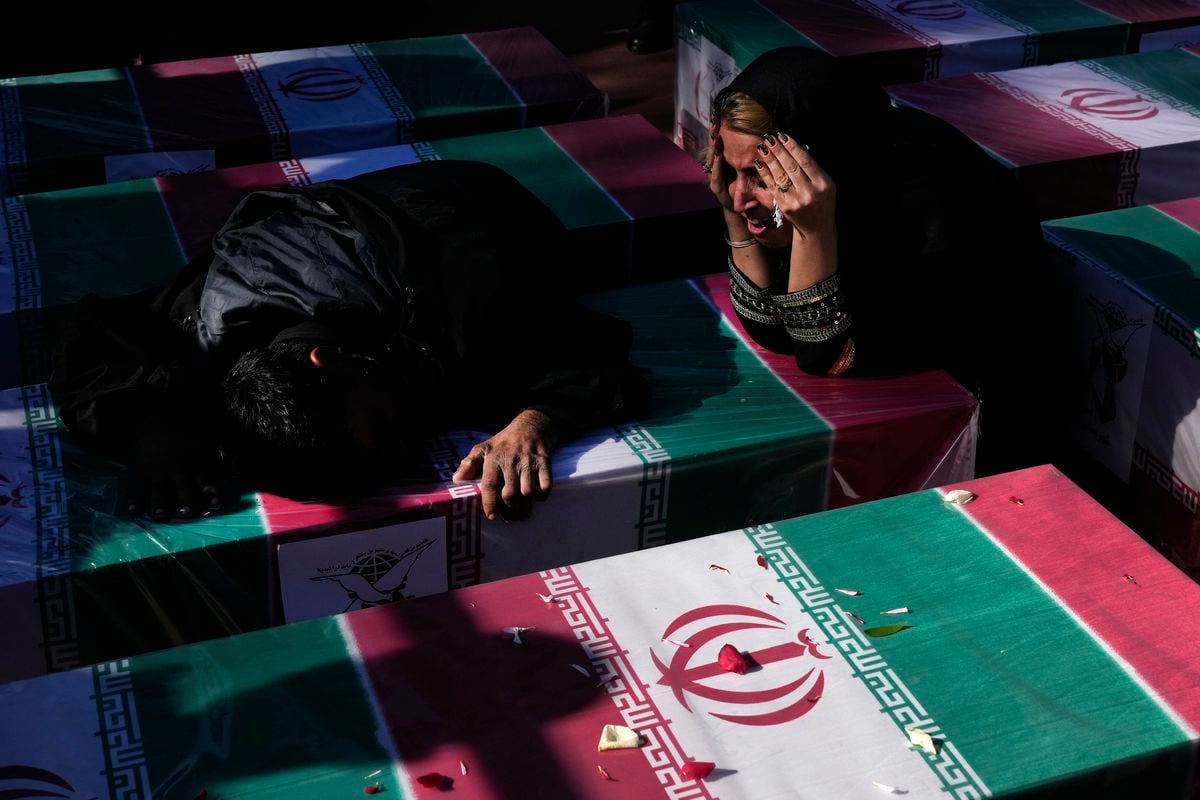When all eyes were focused at the beginning of the week on the repercussions of the assassination of the second man in the Palestinian Hamas movement, Saleh Al-Arouri, in an attack in Beirut that showed every indication of Israeli action, two powerful explosions rocked the Iranian city of Kerman. In a move to dispel the confusion surrounding the events on Thursday, the terrorist group…
Subscribe to continue reading
Read without limits
When all eyes were focused at the beginning of the week on the repercussions of the assassination of the second man in the Palestinian Hamas movement, Saleh Al-Arouri, in an attack in Beirut that showed every indication of Israeli action, two powerful explosions rocked the Iranian city of Kerman. On Thursday, in an attempt to dispel the confusion initially surrounding the events, the Islamic State (ISIS) claimed responsibility for the attack, which killed at least 91 people and became the deadliest in Iran's modern history.
The attack, carried out amid strong regional tension caused by Israel's devastating military offensive in Gaza, put ISIS back on the map. This is the latest ominous reminder of the organization's presence in different latitudes of the world and its ability to continue carrying out high-impact operations, despite its defeat in Syria and Iraq – where it controlled large areas of territory between 2014 and 2019. Many of its top leaders and commanders have been weakened in recent years by competition from rival groups.
In 2023, the number of attacks claimed by the Islamic State and its affiliates fell by 53% compared to the previous year, from 1,811 to 838, according to a BBC tally based on official statements from the group and its supporters. However, the group is still capable of carrying out hundreds of attacks annually (more than two attacks per day on average in 2023), taking advantage of local political and security vulnerabilities and gaps.
A challenge to Iran
It is likely that the attack that occurred in the city of Kerman, during a memorial ceremony commemorating the death of General Qasem Soleimani by an American drone in 2020, was carried out by the branch of the Islamic State in Khorasan (ISIS). . This sub-group of the organization was formed in early 2015 and operates mainly in Afghanistan and Pakistan, although it also operates in some surrounding countries, such as Iran, and in recent years it has modified its tactics and adapted its actions according to the circumstances.
“After the Taliban seized power in Afghanistan in August 2021, there was a noticeable increase in ISIS-K attacks. In response, the Taliban began a large-scale operation against its members and sympathizers, killing dozens and arresting hundreds, and attacks declined significantly,” says Abdul Sayed, an independent researcher specializing in jihadist affairs, from Sweden, in the region.
Join EL PAÍS to follow all the news and read without limits.
Participate
“However, in mid-2022, ISIS-K adopted a new strategy, focusing on large suicide bombings, rather than frequent small bombings, targeting foreign diplomats, foreign nationals, influential Taliban leaders, religious figures, and key facilities in Kabul.” He explains.
The researcher adds that between January and May 2023, “the Taliban eliminated more than a dozen key leaders of ISIS-K, leading to a significant decline in their attacks in Afghanistan and a long-term cessation” of actions. In 2023, ISIS attacks decreased by 86% compared to the previous year and 93% compared to 2021, according to BBC statistics.
However, the group's most active operational network currently, according to Syed, is in the Bajaur tribal region, in northwestern Pakistan and on the border with Afghanistan. The expert says that “details regarding the whereabouts of ISIS-K leaders and members are still elusive,” but points out that Taliban intelligence operations indicate the presence of cells in Kabul, in the northeastern province of the country on the border with Pakistan, and in the northern provinces bordering Tajikistan and Uzbekistan. There is also evidence of their presence in the western Herat province bordering Iran.
Some analysts have warned that, due to greater counter-terrorism pressure from the Taliban, ISIS-K could have chosen not only to commit fewer attacks, despite their greater impact, but also of a greater regional nature. In this sense, one of the most threatening countries is precisely Iran, due to the radically anti-Shiite stance taken by ISIS – a group that follows the Sunni branch of Islam – its direct opposition to the Iranian authorities and its scope to recruit followers among its ranks. Iranian citizens. Sunnis who oppose the Tehran government. Moreover, Iran does not have the influence or relevant militias in Afghanistan that would allow it to confront ISIS-K, as is the case in Iraq and Syria, through various pro-Iranian armed groups and proximity to the government of Bashar al-Assad. .
The Kerman attack is not the only major attack carried out by ISIS recently, nor the first major attack against Iran. Last summer, the group killed more than 60 people and wounded more than a hundred in another suicide attack carried out during an election rally in Pakistan. In October 2022, the terrorist organization claimed responsibility for another attack in the Iranian city of Shiraz that left more than 10 dead and dozens wounded. In 2018, he claimed responsibility for an attack during a military parade in the southwestern Iranian city of Ahvaz, killing 25 people. A year before that, it struck central Tehran with two attacks, against the Iranian Parliament and the shrine of Ruhollah Khomeini, the founder of the Islamic Revolution, in which 18 people were killed. The Iranian authorities accused the Islamic State of launching other attacks in the country, and claimed to have thwarted dozens of them.
However, there remain unsolved elements of the recent attack in Iran. “It is too early to determine the degree of involvement of the ISIS-Khorasan network in Afghanistan [en el atentado de Kermán]“After the incident, pro-Taliban media attributed the incident to the ISIS network in Tajikistan,” says Syed, who highlights that “Iranian officials also confirmed that one of the suicide bombers was of Tajik nationality.” The researcher speculates that “if he was indeed involved “It is possible that ISIS-K will announce the details soon.”
Global network
In addition to the Khorasan Province (which in jihadi terminology refers to the historical region that includes present-day Afghanistan, eastern Iran, and the regions of Tajikistan, Turkmenistan, and Uzbekistan), the Islamic State maintains multiple branches in other parts of the planet. Still active. Iraq and Syria are the two places that have had to transform the most in recent years due to factors such as the strengthening of the Syrian regime and the Iraqi military apparatus, its loss of territory, influence, resources and recruits, and the rapid elimination of its leaders. . Last year, its alleged attacks in Iraq decreased by 65% compared to 2022, and in Syria by 60%. However, the organization is still capable of carrying out dozens of operations, including some particularly complex ones, such as those it carried out in Syrian prisons to free members of its ranks, and it continues to exploit security and stability gaps in areas such as central Syria to strengthen itself.
The situation is markedly different in sub-Saharan Africa, where ISIS has five regional branches and has sought to expand its influence in recent years to confront setbacks in the Middle East. There, the group has exploited the greater instability and reduced counter-terrorism pressure resulting from multiple coups d'état, especially in the Sahel, heightening the political, social, and economic grievances of local populations.
In 2023, attacks by various branches of the Islamic State in sub-Saharan Africa also decreased compared to the previous year, but the region accounts for up to 60% of the total attacks declared by the organization in the world. Its most active branches are those in West Africa, especially in northeastern Nigeria and around Lake Chad, and in the Sahel region, especially in Mali. Its provinces in Central Africa and Mozambique also pose a notable threat.
In Egypt, where the Islamic State's Sinai branch claimed more than 100 attacks in 2022 and temporarily occupied some towns in 2020, the threat has been almost completely crushed.
Follow all international information on Facebook And sor in Our weekly newsletter.

“Unapologetic tv specialist. Hardcore zombie trailblazer. Infuriatingly humble problem solver.”

:quality(85)/cloudfront-us-east-1.images.arcpublishing.com/infobae/VKLL7VFKVFHLFL7M4GYNPY2O5A.jpg)
:quality(85)/cloudfront-us-east-1.images.arcpublishing.com/infobae/XAC7BNFM4RHILJYFO72YPJTMQ4.jpg)




More Stories
Best areas to rent a house in Miami
Breaking news on Gaza and pro-Palestinian protests on American campuses, live: news and more
Vietnam Airlines performs well in the first quarter of 2024